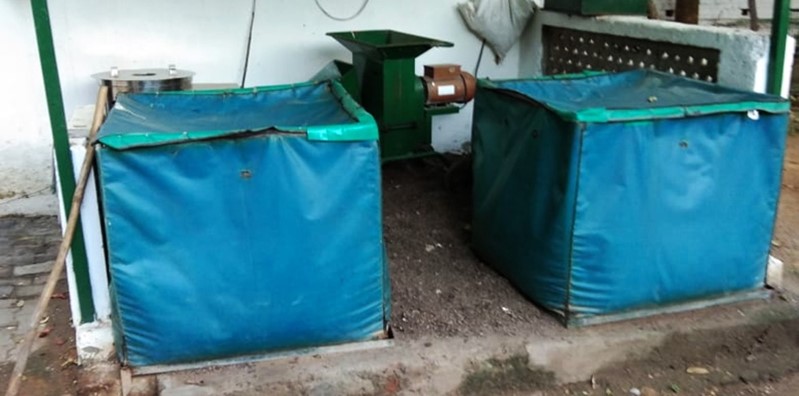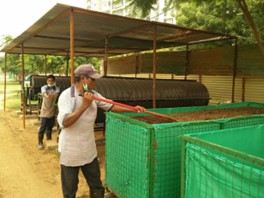Solid waste mountains on outskirts of city borders and sometimes even within centre of city are fairly common sights in almost all sections of urban and rural India. In today’s fast paced life, convenience is leading to consumerism. Always increasing populations, rapid changing lifestyles, making us impulsive buyers and above all two plus years of pandemic (and still continuing) which changed our habits of getting everything wrapped up in plastic and delivered at doorsteps, are few of top reasons for enormous amounts of daily municipal waste. Every dine out, every order placed or returned, every Zomato or Swiggy rider on road, every medicine we order, everything that we eat leads to an unending cycle of high waste quantum. And to top this up, an additional stream of personal protective kits aka PPE kits, disposable masks, gloves etc has also reached household waste stream, which was earlier limited to biomedical waste. Studies have revealed that the quantum of waste which was earlier generated in range of 0.2 - 0.4 kg/capita/day in urban cities has increased up to 0.5-0.6 kg/capita/day in metropolitan cites. Biomedical waste report from Central Pollution Control Board revealed that during January and May 2021, 22 of the 35 states and Union Territories generated more biomedical waste than they can handle. The capacity of facilities to treat biomedical waste is nearly saturated in Maharashtra, Goa, Manipur, Andhra Pradesh, Meghalaya, Rajasthan and others.
Waste generation is high while capacity of treatment facilities are overburdened. Many cities don’t even have Municipal waste processing units and even sites to dump further and everything which leaves sources finally ends up at land outside or within our cities. To handle this waste Urban Local Bodies aka Municipalities are spending more than 80% of their MSW budget just for door to door collection and transportation.
A simple yet effective solution to manage this quantum and is cost effective is decentralised waste processing.
What is this decentralised waste management?
It refers to a system wherein waste is processed at or near its source of generation and does not have to be transported over long distances to be eventually processed at a single remote location. The level of decentralization can vary, with processing being done either at the individual household level or a housing society level or even at a broader ward/sector/cluster level.
Why Decentralised?
Suppose there is no inhouse kitchen and only available one is community Kitchen in whole city on outskirts and everyone have to travel a minimum 6 times to prepare 3 meals. Can you imagine such a setup to be effective and workable?
Decentralised system has same advantages of inhouse kitchen like cooking within reach, cooking what we want and when we want and no dependency/relying on a single community kitchen in the city. You have better control, its more economical and in case community kitchen is dysfunctional on any day, the entire city doesn’t have to go hungry!
This decentralised system will also ensure better waste segregation and will have effective monitoring with shortest loop for feedback, revert and improve/implement, which mostly all waste management systems in country are struggling for a very long time. Level of segregation is not only first step but steppingstone for defining success or failure of any waste management system. Also, community can be more responsible for waste which they generate and manage.
Not only on-site waste processing cuts down waste quantum but also reduces unnecessary stress on roads for transportation of waste to >25km waste ride to landfill site, improves air quality with less emissions, reduces land requirements by ULBs (which is already in shortage), reduces damage of environment from untreated dump, and improve health of our waste warriors. Due to less quantum of waste handled, automatic, semi-automatic or mechanised innovative systems units can also be explored for reducing human interference.
Considering growing Indian population, it will be fair to start with Bulk waste generators at first and then reach out to individuals for decentralised approach of waste management. Every city has BWGs who all together contributes to 50-60% of any city’s waste quantum and in one go can significantly reduce waste load, Municipality Budget to transport and process waste and land requirement for centralised processing by Urban Local Bodies.
Who are Bulk waste generators (BWGs) and what are their responsibilities?
As per Solid waste Management Rules 2016, “Bulk Waste Generator” means anyone having an average waste generation rate exceeding 100kg per day (of all waste streams put together).
Below mentioned are the entities who falls under BWG category:
|
Residential |
• The cooperative group housing society having more than 300 flats, markets* • Gated communities with more than 5000 sq mts area • Central Government Residential colonies* · RWAs |
|
Commercial |
• Restaurant(s) with more than 200 seating capacity* • All 4- and 5-Star Hotel(s)* • Shopping Complex(es)/ Mall(s) having built-up area of more than 5,000 sq.mts. * |
|
Government, Public Sector or Private Bodies |
• Central Government Ministries, Departments and Undertakings • State Government Ministries, Departments and Undertakings • Local Bodies • Public Sector Undertakings • Private Sector Offices, Complexes, Buildings |
|
Social Infrastructure |
• Places of Worship • Clubs • Hospital(s) / Nursing Home(s) which have more than 200 beds whether private or Government* • Stadia and Sports Complexes • Marriage Halls • Recreation/Entertainment Complexes • Hostel/Schools, Colleges, Universities, Educational & Training Institutions having more than 500 students for accommodation* • Railway Stations / Bus Stations/ Airports etc. |
*Bulk Garbage Generators as defined by National Green Tribunal (NGT) in Court Order of Original application No. 199 of 2014 in the matter of Almitra H. Patel Vs UOI and application no. 281 of 2016 in the matter of Kudrat Sandhu Vs Govt. of NCT of Delhi & Govt. of India
As per the SWM Rule, bulk waste generators are responsible for:
- Onsite waste segregation into 3 categories namely biodegradable, non-biodegradable and domestic hazardous waste
- Process wet waste (Bio-degradable waste) within premises itself and develop a system of reuse of products of processing, that is, compost or biogas etc
- Handover segregated dry wastes to ULB waste collector or agency authorized by ULB to collect waste on its behalf as per the direction or notification by the local authorities from time to time
- Store horticulture waste and garden waste generated from premises separately in own premises and carry out composting in compost pits within the premises. In case of non-availability of land, dispose off as per the directions of the urban local body from time to time
- Store separately Construction & Demolition waste generated in own premises and dispose off as per the Construction & Demolition Waste Management Rules, 2016
- In addition to above, bulk waste generators are required not to mix E-waste - it should be separately stored as and when generated and should be handed over to recycling chain
To assist Urban Local Bodies in Identification, Implementation and Monitoring of BWGs and to simplify the process, Ministry of Housing and Urban Affairs has released a guidebook “Bulk Solid Waste Generators” which provides step by step advice on various steps that need to be followed by ULBs. The guidebook also has database of more than 70+ tech providers for onsite processing for BWGs. PDF copy of Guidebook is available on http://cpheeo.gov.in and on CPCB website.
How can BWGs choose Community composting Solution best suited for them?
The Guidebook released by MOHUA and Swachh Bharat Mission share a long list of composting solutions and technologies for assisting a community. But one system which is well suited for residential complex may not be suitable for club house, even if quantum of waste generation is same. Every system has its advantages and disadvantages depending on where you want to compost, how much space you have available, the amount of compost you would like to make, cost of technology, and its maintenance.
While choosing the right solution, 6 simple rules should always be kept in mind:
- Keep it close: Processing of waste as close to source of generation as possible, will save both transportation cost (which is usually major part of budget) and society can reuse its products easily. Avoid off-site options.
- Consider all negative spaces: every society, institute or commercial places has few areas which are not used due to their difficult or different designs like area around or near powerhouse/transformers or roof-top or corner of playground etc. Remember with upgraded technologies, now system can be designed based on any area constraints.
- Let Nature do its part: Composting is a natural process which takes minimum 21 days to actually digest waste (cycle can be 7-10 days short during peak summer and long during winters or rainy days). Machines can only aid in transforming quantum to a manageable/ compostable scale, but ultimately, it’s the microbes who are the boss of process. Add on units like shredding and dewatering will work for large quantum.
- Air or No Air: wet waste can be decomposed either in presence of air, called Aerobic process, or in absence of Air, called An-aerobic. If you have requirement for reuse in form of energy like Biogas/Bio-CNG etc, then tap Methane generated during the process via Bio-methanation plant or else if you want compost, then opt for aerobic solution to the extent possible to minimise methane generation.
- Always keep in Mind Out-product usage: setting up system, operation and reuse of final outcome are 3 important steps for success of any decentralised processing. Assess daily input waste and requirements of output products, be it compost or biogas or bioCNG or any other product before finalisation of technology. Identify and list down usages like how much compost is used by society in parks, in between plants on dividers on road both inside and outside society, how many flats with balcony garden who can use compost. Plan out how much can be reused and how much can be sold, which can be an extra income to the society.
- Share responsibility and community engagement: The more members of society are involved, the more successful the system will be. Promote and arrange events around waste management to make On-site process popular, just like we are proud of our household assets, we should also own and promote waste processing within premises. Remember, every single Ton of waste processed at site is waste saved from reaching landfill outside city.
A few operational composting sites in Gurugram by Societies and institutes





